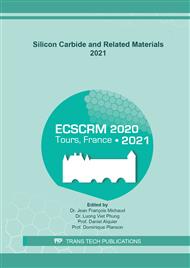[1]
M. Waltl, Defect Spectroscopy in SiC Devices,, IEEE International Reliability Physics Symposium (IRPS), 2020,.
DOI: 10.1109/irps45951.2020.9129539
Google Scholar
[2]
G. Rescher, G. Pobegen, T. Aichinger, and T. Grasser, On the Subthreshold Drain Current Sweep Hysteresis of 4H-SiC nMOSFETs,, IEEE International Electron Device Meeting (IEDM), (2016).
DOI: 10.1109/iedm.2016.7838392
Google Scholar
[3]
V. V Afanas'ev, A. Stesmans, F. Ciobanu, G. Pensl, K. Y. Cheong, and S. Dimitrijev, Mechanisms Responsible for Improvement of 4H-SiC/SiO2 Interface Properties by Nitridation,, Applied Physics Letters, vol. 82, no. 4, p.568–570, 2003,.
DOI: 10.1063/1.1532103
Google Scholar
[4]
G. Y. Chung et al., Effect of Nitric Oxide Annealing on the Interface Trap Densities near the Band Edges in the 4H polytype of silicon carbide,, Applied Physics Letters, vol. 76, no. 13, p.1713–1715, 2000,.
DOI: 10.1063/1.126167
Google Scholar
[5]
J. Rozen et al., Suppression of Interface State Generation upon Electron Injection in Nitrided Oxides grown on 4H-SiC,, Applied Physics Letters, vol. 91, no. 15, p.153503, 2007,.
DOI: 10.1063/1.2790374
Google Scholar
[6]
H. Li, S. Dimitrijev, H. B. Harrison, and D. Sweatman, Interfacial Characteristics of N2O and NO Nitrided SiO2 grown on SiC by Rapid Thermal Processing,, Applied Physics Letters, vol. 70, no. 15, p.2028–2030, 1997,.
DOI: 10.1063/1.118773
Google Scholar
[7]
S. Kuroki et al., 4H-SiC Pseudo-CMOS Logic Inverters for Harsh Environment Electronics,, Material Science Forum, vol. 897, p.669–672, 2017,.
DOI: 10.4028/www.scientific.net/msf.897.669
Google Scholar
[8]
J. R. Brews, A Charge-Sheet Model of the MOSFET,, Solid State Electronics, vol. 21, no. 2, p.345–355, 1978,.
DOI: 10.1016/0038-1101(78)90264-2
Google Scholar
[9]
C. Schleich et al., Physical Modeling of Charge Trapping in 4H-SiC DMOSFET Technologies,, IEEE Transactions on Electron Devices, vol. 68, no. 8, p.4016–4021, 2021,.
DOI: 10.1109/ted.2021.3092295
Google Scholar
[10]
B. Kaczer et al., Origin of NBTI Variability in Deeply Scaled pFETs,, IEEE International Reliability. Physics Symposium (IRPS), p.26–32, 2010,.
DOI: 10.1109/irps.2010.5488856
Google Scholar
[11]
A. J. Lelis et al., Time Dependence of Bias-Stress-Induced SiC MOSFET Threshold-Voltage Instability Measurements,, IEEE Transactions on Electron Devices, vol. 55, no. 8, p.1835–1840, 2008,.
DOI: 10.1109/ted.2008.926672
Google Scholar
[12]
B. Kaczer et al., Ubiquitous Relaxation in BTI Stressing - New Evaluation and Insights,, IEEE International Reliability. Physics Symposium (IRPS), p.20–27, 2008,.
DOI: 10.1109/relphy.2008.4558858
Google Scholar
[13]
B. Ullmann, K. Puschkarsky, M. Waltl, H. Reisinger, and T. Grasser, Evaluation of Advanced MOSFET Threshold Voltage Drift Measurement Techniques,, IEEE Transactions on Devices and Material Reliability, vol. 19, no. 2, p.358–362, 2019,.
DOI: 10.1109/tdmr.2019.2909993
Google Scholar
[14]
K. Puschkarsky, H. Reisinger, G. A. Rott, C. Schlünder, W. Gustin, and T. Grasser, An Efficient Analog Compact NBTI Model for Stress and Recovery Based on Activation Energy Maps,, IEEE Transactions on Electron Devices, vol. 66, no. 11, p.4623–4630, Nov. 2019,.
DOI: 10.1109/ted.2019.2941889
Google Scholar
[15]
C. Schleich et al., Physical Modeling of Bias Temperature Instabilities in SiC MOSFETs,, IEEE International Electron Devices Meeting (IEDM)., 2019,.
DOI: 10.1109/iedm19573.2019.8993446
Google Scholar
[16]
T. Grasser, H. Reisinger, P. J. Wagner, F. Schanovsky, W. Goes, and B. Kaczer, The Time Dependent Defect Spectroscopy (TDDS) for the Characterization of the Bias Temperature Instability,, IEEE International Reliability Physiscs Symposium (IRPS), p.16–25, 2010,.
DOI: 10.1109/irps.2010.5488859
Google Scholar
[17]
K. B. Sutaria, A. Mohanty, R. Wang, R. Huang, and Y. Cao, Accelerated Aging in Analog and Digital Circuits with Feedback,, IEEE Transactions on Device and Material Reliability, vol. 15, no. 3, p.384–393, 2015,.
DOI: 10.1109/tdmr.2015.2456893
Google Scholar
[18]
V. Huard, M. Denais, and C. Parthasarathy, NBTI Degradation: From Physical Mechanisms to Modelling,, Microelectronics Reliability, vol. 46, no. 1, p.1–23, 2006,.
DOI: 10.1016/j.microrel.2005.02.001
Google Scholar
[19]
J. W. McPherson, Reliability Physics and Engineering,, 2019,.
Google Scholar
[20]
T. Grasser, Stochastic Charge Trapping in Oxides: From Random Telegraph Noise to Bias Temperature Instabilities,, Microelectronics Reliability, vol. 52, no. 1, p.39–70, 2012,.
DOI: 10.1016/j.microrel.2011.09.002
Google Scholar
[21]
M. Waltl, G. Rzepa, A. Grill, W. Goes, J. Franco, and B. Kaczer, Superior NBTI in High-k SiGe Transistors - Part I : Experimental,, IEEE Transactions on Electron Devices, vol. 64, no. 5, p.1–8, 2016,.
DOI: 10.1109/ted.2017.2686086
Google Scholar
[22]
G. Rzepa et al., Comphy - a compact-physics framework for unified modeling of BTI,, Microelectronics Reliability, (2018).
Google Scholar
[23]
D. Waldhoer et al., Toward Automated Defect Extraction from Bias Temperature Instability Measurements,, IEEE Transactions on Electron Devices, vol. 68, no. 8, p.4057–4063, 2021,.
DOI: 10.1109/ted.2021.3091966
Google Scholar
[24]
https://www.wolfspeed.com/document-library/?documentType=ltspice-and-plecsmodels& productLine=power., (last accessed June 2021).
Google Scholar
[25]
H. Amrouch, S. Mishra, V. Van Santen, S. Mahapatra, and J. Henkel, Impact of BTI on Dynamic and Static Power: From the Physical to Circuit Level,, IEEE International Reliability Physics Symposium (IRPS), p. CR3.1-CR3.6, 2017,.
DOI: 10.1109/irps.2017.7936352
Google Scholar


